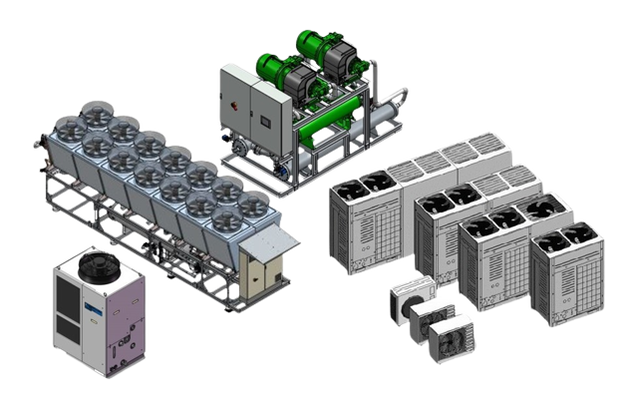|
Heat pumps and refrigeration systems are caught between energy-efficient performance and acoustic compatibility with the neighbourhood. A central phenomenon in this context is sound masking effects, which significantly influence both the technical design and the acoustic perception of these systems. These effects result from the complex interaction of different frequency ranges and operating conditions, which often lead to unexpected noise emissions, even if individual components have been optimised.
Sound masking effects describe the phenomenon in which the reduction of certain frequency ranges leads to other frequency components being perceived subjectively louder. This effect is based on psychoacoustic interactions: The human ear is less able to localise low frequencies and perceives them as more dominant when the background noise is reduced. With heat pumps, such effects are typically caused by: 1 Frequency overlaps between fan noise (usually medium to high frequencies) and compressor noise (low frequencies), 2 Operating state-dependent modulation as typically occurs during de-icing cycles, in L/W heat pumps where fan speed changes shift the frequency spectrum. 3 Reflection from building structures that amplify certain frequency bands through constructive interference. Air-to-water heat pumps emit sound in the range of 30-70 dB(A), with the critical frequency bands lying between 63 Hz (low humming) and 4 kHz (high humming). Masking effects occur in particular when high frequencies are attenuated by sound insulation measures, making low frequency components more prominent in relative terms. For example, attenuating a 2 kHz signal by 10 dB(A) can result in a 100 Hz hum being perceived as 6-8 dB(A) louder One of the main causes of masking effects are thermodynamically induced changes in operating conditions. At air temperatures around 0°C with high humidity, ice forms on the evaporator fins, which leads to the following effects: 4 Pressure losses in the air flow force higher fan speeds (frequency increase of 15-30%). 5 Compressor load changes when switching to defrosting modes generate pulse-like low-frequency oscillations 6 Material expansion on iced components cause additional resonances in the 80-200 Hz range. These dynamic changes are superimposed on the basic noise spectrum and lead to non-linear masking effects that can hardly be detected by stationary sound measurements. The interaction of these spectra leads to complex superpositions. For example, the 100 Hz component of the compressor can suppress the perception of 800 Hz fan sounds, while at the same time harmonics at 1600 Hz are amplified by resonances in the housing.
0 Comments
Leave a Reply. |
AuthorWe specialize in reducing noise emissions and increasing the performance of HVAC and industrial systems. Archives
January 2025
Categories |
We support you in solving noise problems - even at your premisesSilent Engineering
di Vicari Romolo Via Trento 22 IT-23875 OSNAGO (LC) www.forcotech.com [email protected] Phone: + 39 349 431 73 42 Contact Form VAT ID: 03833150133 Fiscal Code: VCRRML61E28Z133R Data Protection, Privacy, GDPR More Information ©Copyright (copyright notice) 2019/ 2020 / 2021 / 2022 / 2023 / 2024 - Silent Engineering - All contents of this website are subject to copyright. All content, in particular texts, images, logos, product names and graphics are protected by copyright. All rights, including reproduction, publication, editing and translation, require the express written authorisation of the website owner. This will only be granted after verification via PEC mail or registered letter. |
Our Brands around soundproofing |



 RSS Feed
RSS Feed




